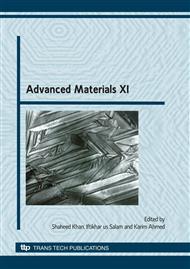[1]
K. Otsuka, C.M. Wayman, Shape Memory Materials, Cambridge University Press, Cambridge, 1998, p.1.
Google Scholar
[2]
MacQueron, J.L., Morin, M., Gue´nin, G., Planes, A., Elgueta, J., Castan, T., 1991. Atomic ordering and martensitic transition in a Cu-Zn-Al shape memory alloy. J. Phys. IV C4-1 (9), 259-263.
DOI: 10.1051/jp4:1991439
Google Scholar
[3]
R.J. Wasilewski, S.R. Butler, J.E. Hanlon, On the Martensitic Transformation in TiNi, Metals Science Journal, 24 (1967) 104-110.
DOI: 10.1179/msc.1967.1.1.104
Google Scholar
[4]
K. Otsuka, X Ren, Physical metallurgy of Ti-Ni-based shape memory alloys, Progress in Materials Science 50 (2005) 511-678.
DOI: 10.1016/j.pmatsci.2004.10.001
Google Scholar
[5]
H.C. Ling, R. Kaplow, Phase Transitions and Shape Memory in NiTi, Metallurgical Transactions 11A (1980) 77-83.
DOI: 10.1007/bf02700440
Google Scholar
[6]
T. Todoroki, H. Tamura, Effect of Heat Treatment after Cold Working on the Phase Transformation in NiTi Alloy, Transactions Japan Institute of Metals 28 (1987) 83-94.
DOI: 10.2320/matertrans1960.28.83
Google Scholar
[7]
M. Pattabi, K. Ramakrishna, K.K. Mahehsh, Effect of thermal cycling on the shape memory transformation behavior of NiTi alloy: Powder X-ray diffraction study, Materials Science and Engineering A 448 (2007) 33-38.
DOI: 10.1016/j.msea.2006.09.052
Google Scholar
[8]
H. Funakubo, Shape Memory Alloys, Gordon & Breach Publishing Group, Amsterdam, 1987, p.1.
Google Scholar
[9]
T.H. Nam, T. Saburi, Y. Nakata and K. Shimizu, Shape memory characteristic and lattice deformation In Ti-Ni-Cu alloys, Materials Transactions JIM 31 (1990) 1050-1056.
DOI: 10.2320/matertrans1989.31.1050
Google Scholar
[10]
F. Fukuda, T. Kakeshita, M. Kitayama and K. Saburi, Effect of ageing on martensitic transformation in a shape memory Ti40. 5Ni10Cu alloy, Journal de Physique IV5(1995) C8-717.
DOI: 10.1051/jp4/199558717
Google Scholar
[11]
T. Saburi, MRS Int'l. Mtg. on Adv. Mats. Vol. 9, 1989, pp.77-91.
Google Scholar
[12]
T. Goryczka a, *, J. Van Humbeeck b, a Institute of Materials Science, University of Silesia, ul. Bankowa 12, 40-007 Katowice, Poland.
DOI: 10.3161/00159301ff2019.62.2.117
Google Scholar
[13]
P. Bassani and S. Besseghini, NiTiCu shape memory alloy: Superplastic elongation during thermal cycling, CNR-TeMPE, Corso Promessi Sposi 29, 23900 Lecco, Italy.
DOI: 10.1051/jp4:2001864
Google Scholar
[14]
Ch. Somsen, J. Kastner, E.F. Wassermann, Ph. Boullay1 and D. Schryvers1, Microstructure of quenched Ni-rich Ni-Ti shape memory alloys, Labor fur Experimentelle Tieftemperaturphysik, Gerhard Mercator Universitat, Lotharstrasse A273-275 (1999) 310.
DOI: 10.1051/jp4:2001874
Google Scholar


